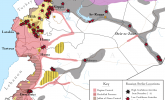 |
 |
Russian Airstrikes in Syria: December 3 - 12, 2015
Russia and the Syrian regime faced significant setbacks in Syria this week as ISIS recaptured the towns of Maheen and Hawareen in the southeastern countryside of Homs on December 9. ISIS successfully repelled attempts by regime forces to recapture these towns on December 10, despite a large concentration of Russian airstrikes in the area. The regime previously seized Maheen and Hawareen on November 23 as components of a larger offensive to retake Palmyra further east in Homs Province. The seizure of Palmyra would represent a significant victory for both Syrian President Basar al-Assad and Russia as Russia continues to present itself and the Assad regime as effective anti-ISIS actors in Syria. Following these setbacks, Russian Defense Minister Sergei Shoigu claimed ISIS’s influence in Syria is increasing and that the militant group controls around 70% of Syria.
Russian airstrikes in Syria, however, continue to be concentrated in rebel-held terrain in Aleppo, Idlib, and Hama Provinces, targeting positions across rebel front lines with the regime, ISIS, and Kurdish YPG forces. Russian airstrikes continued to target locations along the key rebel ground line of communication (GLOC) from northern Aleppo City to the Turkish border, coinciding with a recent ISIS offensive to sever the GLOC. Rebel forces, however, successfully slowed ISIS’s advance and recaptured the town of al-Hamzat in northern Aleppo from ISIS on December 11, despite the concentration of Russian strikes in the area. Russian airstrikes also targeted rebel front lines near the Kurdish Afrin canton in northwestern Aleppo, a site of recent clashes between rebel and Kurdish YPG forces.
The Russian air campaign continues to provide the regime with asymmetric capabilities against the armed Syrian opposition. A report published by the Syrian Network for Human Rights on December 8 illustrated that Russia’s concentrated air campaign in northern Syria has enabled the regime to direct the majority of its barrel bomb operations towards rebel-held Damascus suburbs and other areas of southern Syria. The use of barrels bombs by the regime and Russia’s continued punishment of local Syrian populations in rebel-held territory, such as the targeting of hospitals, bakeries, and markets, will only further exacerbate the humanitarian situation in Syria and increase refugees flows into Turkey and Europe.
The following graphic depicts ISW’s assessment of Russian airstrike and cruise missile locations based on reports from local Syrian activist networks, Syrian state-run media, and statements by Russian and Western officials. This map represents locations targeted by Russia’s air campaign, rather than the number of individual strikes or sorties.
High-Confidence reporting. ISW places high confidence in reports corroborated both by official government statements reported through credible channels and documentation from rebel factions or activist networks on the ground in Syria deemed to be credible.
Low-Confidence reporting. ISW places low confidence in secondary sources that have not been confirmed or sources deemed likely to contain disinformation.
